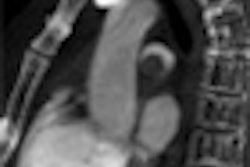Low-dose CT is nearly equivalent to the standard-dose scan for diagnosing appendicitis, and it's accurate enough to serve as a first-line diagnostic modality while delivering less than one-fourth the radiation dose of full-strength CT, researchers report in a study published in the April 26 New England Journal of Medicine.
In two groups comprising more than 900 patients who presented to the emergency department with suspected appendicitis, the negative appendectomy rate in the low-dose CT group was statistically equivalent to that of the standard-dose group, according to the group from South Korea. So despite a few shortcomings -- such as higher odds of needing a second imaging exam to confirm the findings -- the low-dose scan is robust enough to serve as the first-line modality, the authors concluded.
Prone population
Radiologists and other physicians are keenly interested in whether low-dose CT can be used in place of full-dose imaging for a number of clinical applications. With respect to appendicitis, reducing dose is especially important considering the potential risk from ionizing radiation in the population most prone to the condition, they wrote.
"Many patients in whom appendicitis is suspected are children or young adults, and radiation exposure from CT is of particular concern in this population," wrote Dr. Kyuseok Kim, Dr. Young Hoon Kim, and colleagues from Seoul National University, University of Ulsan, and Yonsei University, all in Seoul.
No formal guidelines on dose have been established, but "in response to the more frequent use of CT and the increased awareness of its associated carcinogenic risk, the need for a randomized, controlled trial to establish the role of low-dose CT in diagnosing appendicitis has recently been suggested," they wrote (NEJM, April 26, 2012, Vol. 366:17, pp. 1596-1605).
The trial was conducted at a single hospital in Seoul, and the study design randomly assigned 891 patients (median age, 29 years) with suspected appendicitis to either low-dose CT (444 patients; mean radiation dose, 116 mGy.cm) or standard-dose CT (447 patients; mean dose, 521 mGy.cm). The patients were 15 to 44 years of age, and were undergoing abdominal CT scans for suspected appendicitis based on the clinical judgment of emergency department physicians.
The study's primary end point was the percentage of negative appendectomies performed in patients who received the different CT protocols; low-dose CT was considered to be noninferior to standard-dose CT if the difference was 5.5 percentage points or less.
Secondary end points included the appendiceal perforation rate and the proportion of patients who needed an additional imaging test within seven days of CT. If the diagnosis of appendicitis remained indeterminate after CT and clinical observation, the clinician had the discretion to order ultrasound or a standard-dose CT exam within seven days, to be counted as an additional exam. In patients undergoing surgery, the final diagnosis was made on the basis of surgical and pathological findings.
After injection of iodinated contrast, images were acquired in CT scanners with 16, 64, or 256 detector rows. The reference tube current-time product was set for an effective radiation dose of 2 mSv in the low-dose group and 8 mSv in the standard-dose group, and it was adjusted automatically for the patient's body size. The readers, most of whom had little experience in low-dose CT of the abdomen, routinely reviewed CT images that were 5-mm thick, and they also reviewed images with a thickness of 2 mm as needed with the use of a multiplanar sliding-slab averaging protocol.
The results showed that "the low-dose CT group was noninferior to the standard-dose CT group with regard to negative appendectomy rates," Kim and colleagues reported. "Neither the appendiceal perforation rate nor the diagnostic performance of CT for appendicitis differed significantly between the two groups."
Nonincidental appendectomy was performed in 172 patients in the low-dose group and 186 in the standard-dose group. The negative appendectomy rate was 3.5% (six of 172 patients) in the low-dose group and 3.2% (six of 186 patients) in the standard-dose CT group (difference of 0.3 percentage points; 95% confidence interval: -3.8 to 4.6), the study team reported.
The data suggest that the use of low-dose instead of standard-dose CT in an estimated population of 330 patients would only result in one additional negative appendectomy, according to the authors.
The two groups did not differ significantly in terms of the appendiceal perforation rate, which was 26.5% in the low-dose group and 23.3% with standard-dose CT (p = 0.46), or the proportion of patients who needed additional imaging tests, at 3.2% and 1.6%, respectively (p = 0.09).
"The patients in the low-dose CT group, as compared with those in the standard-dose CT group, were more likely to require additional imaging tests and had a longer interval between the CT examination and appendectomy, which may represent the referring physicians' hesitation to base their decisions on the low-dose CT findings," Kim and colleagues wrote.
Low-dose CT was also limited in terms of the diagnostic confidence for appendicitis and the diagnosis of appendiceal perforation. The low-dose CT group (area under the curve, 0.970) did not differ significantly from the standard-dose CT group (area under the curve 0.975), but diagnostic confidence tended to be more compromised in the low-dose group than in the standard-dose group.
The proportion of patients who required additional imaging tests was 3.2% (14 of 448) in the low-dose CT group, compared with 1.6% (seven of 441) in the standard-dose group (p = 0.09) -- again, a difference that was not statistically significant.
The results are in line with those of previous exploratory studies that support a reduction in radiation dose when CT is used to diagnose appendicitis, the group noted. The excellent imaging capability of modern CT scanners and the simplicity of CT image interpretation in diagnosing appendicitis "may offset the loss in image quality due to low-dose CT techniques," they wrote.
As for limitations, the study setting may have been biased in favor of low-dose CT. In addition, the study was not sufficiently powered to conclusively analyze the potential effects of patient- or radiologist-related factors on negative appendectomy rates or any differences in these effects between the low-dose and standard-dose CT groups.
Importantly, the Korean cohort included very few obese individuals, paving the way for lower overall radiation exposure levels at CT, the authors noted. A similar U.S. population would likely include more overweight patients.
"Overall, our results indicate that low-dose CT, despite its limitations, may be used instead of standard-dose CT as the first-line imaging test, because the ultimate clinical outcomes and diagnostic performance can be maintained if low-dose CT is incorporated into the diagnostic process with selective additional imaging and clinical observation," Kim and colleagues concluded.



















